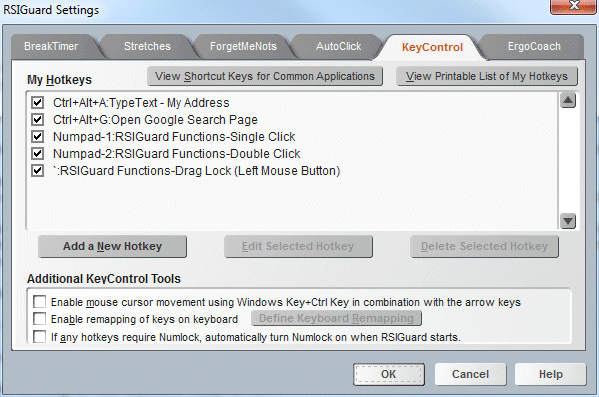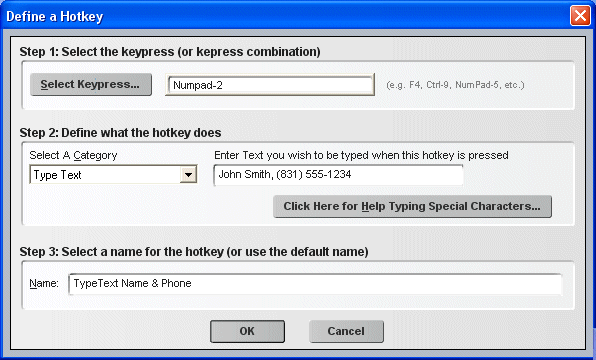
Main
Help Page
|
KeyControl is an RSIGuard feature that helps you:

The "KeyControl Hotkeys" section shows the hotkeys you've already defined. The checkboxes can be unchecked to disable the hotkey, but keep its definition in case you want to enable it again in the future. To the right of the checkbox is the key assigned to the hotkey (e.g. Numpad-1 above means the hotkey is triggered by pressing the 1 key on the numeric keypad). To the right of that is the name of the hotkey.
Clicking "Add a New Hotkey" lets you create a new hotkey.
Clicking "Edit Selected Hotkey" edits the selected hotkey.
Clicking "Delete Selected Hotkey" will delete the selected hotkey.
Viewing Lists of Hotkeys and Shortcut Keys
Clicking on "View Shortcut Keys for Common Applications" lets you select from dozens of common applications to see the shortcut keys that are available. When possible, different versions of the application and operating system are also presented as options.
Clicking on "View Printable List of My Hotkeys" lets you view the list in "My Hotkeys" in your default text viewer (usually Notepad) so that you can print the list of hotkeys.
To create a hotkey, click on "Add a New Hotkey" in the KeyControl settings page.

When you then see the above window, press the key or combination of keys that make up the hotkey keypress you want to define (e.g. F8, or Ctrl+F8, or Alt+Shift+X). After you press the new hotkey, the screen below will be shown to allow you to define the hotkey action (in this example, the user has created a hotkey to type their name and phone number). KeyControl will warn you if the key combination you chose is either not available, or likely to be a poor choice because it conflicts with a common shortcut key (in that case it will offer to let you go ahead anyway or select a new key).

There are various categories of functions that can be assigned to hotkeys. Select the appropriate one for the hotkey you are defining:
Based on the Category you select, fill in the fields presented to complete the definition of the hotkey.
If you select the category RSIGuard Functions, you can select from various RSIGuard-related functions:
Causes RSIGuard to simulate a single click, double click, triple click (which selects a paragraph in some programs) or a right or middle click.
Causes RSIGuard to temporarily disable the AutoClick feature if enabled. AutoClick will begin clicking again after the next mouse click you do (either by physically clicking the mouse or using one of the mouse-clicking hotkeys described in the previous item.
One of the most straining actions you can do with a pointing device like a mouse is to move around while tensely holding down the mouse button (an action known as dragging, even though sometimes you might be selecting rather than dragging). The Drag lock functions allows you to position the mouse where you want to start the dragging or selecting, press a hotkey, and then move the mouse around (thus dragging or selecting) without having to tensely hold the button down or squeeze the pointing device. While drag-lock is actively holding the button down, the icon in the system tray changes into a blinking lock. During a drag, the arrow keys make it easy to make fine horizontal, vertical and diagonal mouse movements -- this can be very useful at times and allows you to precisely drag/select in ways you probably couldn't do previously. Pressing the hotkey again will end the operation by simulating letting go of the mouse button.
The Show RSIGuard function causes the RSIGuard window to become visible and pop to the front of other windows. The Hide RSIGuard function causes the RSIGuard window to be hidden in the system tray. Clicking on the icon in the system tray or using the Show function will make it visible again.
Causes RSIGuard to start your next break early, i.e. immediately. This is useful if you know a break is approaching, and now is a better time for you to take it than later.
Causes RSIGuard to show a ForgetMeNot immediately. If you have enabled ForgetMeNot microbreaks, a microbreak will accompany the ForgetMeNot.
Pressing this hotkey will toggle the AutoClick feature on and off allowing you to quickly enable the feature when you want it, and disable it when you don't.
Typing special characters with "Type Text" hotkeys
If you select the "Type Text" hotkey category, you can create a hotkey that types a sequence of keystrokes. If you enter something like: "(800)555-1234" then the hotkey will automatically type this phone number. In addition to regular text, you can type special characters with a Type Text hotkey using special escape sequences. To type each of the following characters, use the text shown:
| The key you want typed | What you should put in
the hotkey text (except for F-keys, these are not case sensitive) |
| Ctrl/Control key | <ctrl> (or <ctrlr>
to specify right Ctrl key) (include characters to be "modified" in < >, e.g. <ctrlc> to specify Ctrl+C for copy hotkey) |
| Alt key (Option on Mac) | <alt> (or <altr>
to specify right Alt key) (use nested < / > symbols for special key combinations, e.g.<alt<F4>> to type the Alt-F4 to close the current application) |
| Shift key | <shift> |
| Windows Key (Win only) | <winkey> |
| Apple Key (Mac only) | <applekey> |
| Tab | <tab> |
| Enter or Return | <enter> |
| Backspace | <backspace> |
| Up arrow | <up> |
| Down arrow | <down> |
| Left arrow | <left> |
| Right arrow | <right> |
| Esc (Escape) | <esc> |
| Page Up | <pageup> |
| Page Down | <pagedown> |
| Home | <home> |
| End | <end> |
| Insert | <insert> |
| Delete | <delete> |
| Scroll Lock | <scrolllock> |
| Pause | <pause> |
| Right Click Key | <rightclickkey> |
| Break Key | <break> |
| Less than '<' | <lessthan> |
| Greater than '>' | <greaterthan> |
| F-keys | <F1> through
<F12> (must use capital F) |
In the examples below, you will also see two ways to split the down and up portion of a keystroke. This is useful for creating hotkeys that do things like "press Ctrl-Left Click".
Examples:
John Smith<Enter>123 Any St.<Enter>BigTown, CA 01234 - types your address on 3 lines
supervisor@company.com<tab><tab>My weekly report<tab> - enters fields in weekly email
<Ctrlc> (or <Applekeyc> on Mac) - copy the selection
<Ctrlv> (or <Applekeyv> on Mac) - paste
<Ctrlx> - presses Ctrl+x
<CtrlX> - presses Ctrl+Shift+x (which is equivalent to Ctrl+X)
<Ctrl<Alt<Shift<F5>>>> - presses Ctrl+Alt+Shift+F5
To create a hotkey that does a Ctrl-Left Click, you would select the category "Do RSIScript Command" and enter the command: "type <ctrl;mouse click;type </ctrl>". The first command, "type <ctrl", presses the CTRL key without releasing it. The second command "mouse click" clicks the mouse. The third command "type </ctrl> releases the CTRL key. Click here for more information about writing RSIScript.
Finally, the hotkey's name will automatically be created for the hotkey, but you can change it to be something else if you like before clicking OK to accept the new hotkey.
Controlling the Mouse with Arrow Keys (only available on Windows Stretch/Call Center Editions)
Checking Enable mouse cursor movement with Windows Key in combination
with the arrow keys allows you to control where the mouse cursor
points from the keyboard. Hold down the Windows Key (
![]() ) and then use
the arrow keys to move the mouse. You can combine 2 arrow keys to
move diagonally (e.g. holding the Up arrow and the Left arrow
would make the cursor move diagonally up and to the left). If you
hold down the Ctrl key while moving the cursor, the mouse cursor
will move slower. If you hold down the Shift key while moving the
cursor, the mouse cursor will move faster.
) and then use
the arrow keys to move the mouse. You can combine 2 arrow keys to
move diagonally (e.g. holding the Up arrow and the Left arrow
would make the cursor move diagonally up and to the left). If you
hold down the Ctrl key while moving the cursor, the mouse cursor
will move slower. If you hold down the Shift key while moving the
cursor, the mouse cursor will move faster.